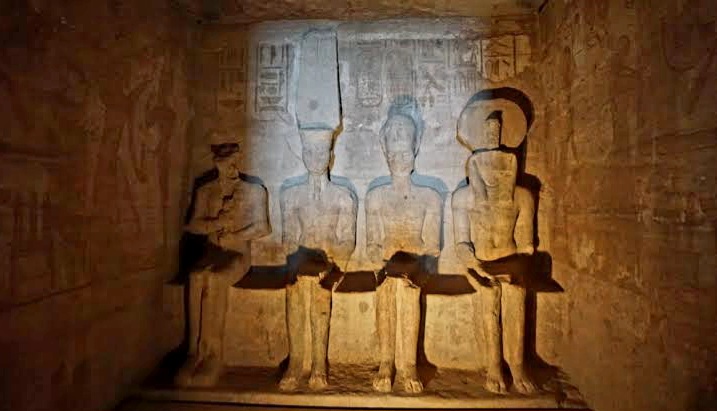Abu Simbel Sun Festival
Get ready to witness a truly incredible phenomenon that has amazed people for centuries – the Abu Simbel Sun Festival. This spectacular event takes place every year in Egypt and attracts visitors from all over the world. As the sun rises on February 22nd and October 22nd, it illuminates the inner sanctum of the Great Temple of Ramses II, casting light on three of its statues while leaving the fourth in darkness.
The Abu Simbel Sun Festival is a remarkable display of ancient Egyptian engineering and astronomical precision. It is believed to commemorate the king’s birthday and his ascendancy to the throne. The alignment of the temple and the intricate design allow for this stunning display to occur only on these specific dates. It’s a unique opportunity to witness history come alive and immerse yourself in the rich heritage of Egypt.
Join the thousands of awe-struck spectators who gather at Abu Simbel to catch a glimpse of this breathtaking event. Marvel at the beauty and symbolism as the rays of the sun bring life and light to the magnificent statues. Don’t miss out on this once-in-a-lifetime experience that will leave you in awe of the ancient wonders of the world.
Historical significance of Abu Simbel
Abu Simbel is an archaeological site located in southern Egypt, near the border with Sudan. It was built during the reign of Pharaoh Ramses II, who ruled Egypt in the 13th century BC. The site consists of two massive rock temples – the Great Temple of Ramses II and the Temple of Hathor. These temples were carved into the side of a mountain, showcasing the incredible architectural skills of the ancient Egyptians.
The temples of Abu Simbel were constructed to demonstrate the power and grandeur of Ramses II. They were dedicated to various deities and served as important religious and political centers during the pharaoh’s reign. The Great Temple of Ramses II, in particular, was built to honor the king himself as a god. Its construction took several years and involved the labor of thousands of workers.
The story behind the Sun Festival
The Abu Simbel Sun Festival has its roots in ancient Egyptian mythology and beliefs. The sun was a sacred symbol of life and rebirth, and the pharaohs were considered the sons of the sun god. The alignment of the temple with the rising sun on specific dates was seen as a divine manifestation of the pharaoh’s power and connection to the gods.
According to legend, the Great Temple of Ramses II was strategically designed so that sunlight would penetrate the inner sanctum and illuminate the statues of the gods seated inside. The statues of Ramses II and Amun-Ra would be bathed in the golden rays of the sun, while the statue of Ptah, the god of darkness, would remain in shadow. This symbolism represented the eternal struggle between light and darkness, good and evil.
Date and location of the festival
The Abu Simbel Sun Festival takes place twice a year, on February 22nd and October 22nd. These dates coincide with important occasions in ancient Egyptian history – the king’s birthday and his coronation day. The festival attracts thousands of visitors who gather at the temples of Abu Simbel to witness this extraordinary event.
Abu Simbel is located in the Nubian Desert, near the border between Egypt and Sudan. It is approximately 280 kilometers southwest of Aswan, the nearest major city. The temples are situated on the western bank of Lake Nasser, a massive reservoir created by the construction of the Aswan High Dam. The remote location adds to the allure of the festival, as it provides a sense of isolation and tranquility.
Cultural activities and traditions during the festival
In addition to witnessing the sun illuminating the temple, visitors can also take part in various cultural activities and traditions during the Abu Simbel Sun Festival. Local performers showcase traditional Egyptian music and dance, providing a glimpse into the rich cultural heritage of the region. Traditional food stalls offer a taste of authentic Egyptian cuisine, allowing visitors to indulge in local delicacies.
One of the most popular traditions during the festival is the reenactment of ancient Egyptian rituals. Dressed in elaborate costumes, performers enact scenes from ancient Egyptian mythology and history. These performances provide valuable insights into the religious beliefs and customs of the ancient Egyptians, further enriching the festival experience.
Tips for attending the Abu Simbel Sun Festival
Attending the Abu Simbel Sun Festival requires some planning and preparation. Here are a few tips to help you make the most of your experience:
1. Book in Advance: The festival attracts a large number of visitors, so it’s advisable to book your tickets and accommodation well in advance. This will ensure that you have a spot reserved and can fully enjoy the festival without any last-minute hassles.
2. Arrive Early: The temples of Abu Simbel open early in the morning, and it’s recommended to arrive well before sunrise to secure a good viewing spot. The crowd can be quite dense, especially on the festival days, so arriving early will give you a better chance of getting a clear view of the temple.
3. Dress Appropriately: The festival takes place in the desert, so it’s important to dress appropriately for the weather. Wear comfortable clothing and footwear, and consider bringing a hat, sunglasses, and sunscreen to protect yourself from the sun.
4. Stay Hydrated: The desert heat can be intense, especially during the day. It’s essential to stay hydrated by drinking plenty of water throughout the festival. Carry a refillable water bottle with you to ensure you have access to clean drinking water.




